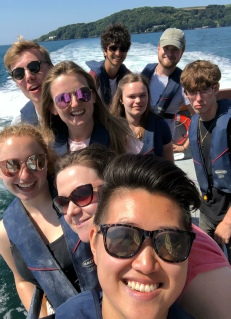Copyright © All rights reserved. Made by Serif. Terms of use | Privacy policy


Plymouth Field Course 2018

Introduction
Plymouth Sound is located in the South West of England and is part of Devon. The Tamar river (Dowr Tamar), which has a source location at Woolley Moor (Cornwall) and has a total length of 98km, forms the main estuary in Plymouth and forms the border between Devon (to the East) and Cornwall (West of Plymouth). The average discharge of the river is ~22.55m3/s.
The Tamar estuary is a mesotidal/macrotidal, partially mixed estuary. It is a designated
Site of Special Scientific Interest (SSSI), a European Special Area of Conservation,
an Area of Outstanding Natural Beauty, part of the Cornwall and West Devon Mining
Landscape and a UNESCO World Heritage Site. In particular, the estuary serves as
an important wintering site for wildfowl and wader birds. It is home to a diverse
set of marine organisms due to a highly variable salinity gradient. The Tamar is
a drowned river valley that was partially flooded during the last 10,000 years. The
age of the geology increases from North to South with the rivers. At the mouth of
the estuary there are Lower Devonian slates and grits. Middle Devonian limestones
flanks the estuary to the East and West. The city of Plymouth consists of slates
and shales from the Upper Devonian period. Rocky reefs dominate in the low salinity
regions of the estuary and inhabitants include unusual species such as the hydroid
(Cordylophora caspia). Both inter-
Plymouth Sound is found at a location of 050.3430N, 004.1430W and covers a span of approximately 6km from its most westerly to easterly point. Its primary source is of marine origin and freshwater inlets from the River Tamar and River Plym contribute. The geology of the Sounds formed during the lower Devonian period to the early Middle Devonian period. Fossil groups belonging to corals, brachiopods, gastropods, orthoconic nautiloids and trilobites can be found here.
Aims
We are a group of third year students taking an oceanography field course in Plymouth for two weeks during summer 2018 (3rd – 13th July). We surveyed the area around Plymouth Sound and the Tamar River using a combination of field and lab work in order to analyse the physical, chemical and biological characteristics of the area and the processes involved.

(Above) The best group of Plym 2k18